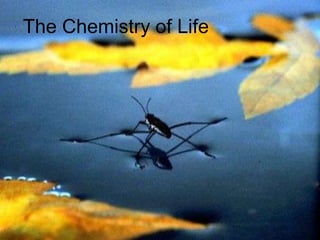
The Chemistry Of Life
- 1. The Chemistry of Life
- 2. The Water Molecule A water molecule is polar because there is an uneven distribution of electrons between the oxygen and hydrogen atoms. (the negative pole is near the oxygen; the positive pole is near the hydrogen atoms; hydrogen bonds form)
- 3. The Water Molecule Because of hydrogen bonding, water molecules stick to one another easily. This is called cohesion. This is why drops of water form beads on smooth surfaces. (This is why some insects can walk on a pond’s surface…)
- 4. The Water Molecule Water molecules also adhere to molecules other than water. This is called adhesion. Water adheres to glass. Water goes against gravity upward – this is called capillary action. Cohesion holds the column of water together as it rises.
- 5. Water molecules can react and form ions… H2O H+ and OH- Water hydrogen ion hydroxide ion In pure water, 1 molecule in 550 million reacts and forms ions. The number of H+ and OH- is equal…water is neutral.
- 6. Define ‘ACID’ and ‘BASE’
- 9. If the pH is too high (base) one chemical will donate some hydrogen ions to lower the pH.How do they work?...
- 10. The Chief Mammalian Blood Buffer is a Mixture of Bicarbonate and Carbon Dioxide The most important buffer in extracellular fluids, including blood, is a mixture of CO2 and bicarbonate ion (HCO3) CO2 acts as an acid – it forms carbonic acid when it dissolves in water - donating hydrogen ions when they are needed. HCO3 is a base, accepting hydrogen ions when there are too many of them Blood pH is determined by a balance betweenHCO3and CO2.
- 11. Too much CO2 or Too Little HCO3 Will Cause ACIDOSIS The balance will swing toward a low pH, producing acidosis, if CO2 is raised or HCO3 lowered. The blood buffering system will accept hydrogen ions, thus keeping the pH constant.
- 12. Too Much HCO3 or Too Little CO2 Will Cause ALKALOSIS The balance will swing the other way (toward a higher pH), producing alkalosis, if CO2 is lowered or HCO3 raised. The blood buffering system will donate hydrogen ions, thus keeping the pH constant. This condition is less common than acidosis.
- 13. Remember the following… When attempts are made to make the blood more alkaline (basic), blood buffers will… …DONATE hydrogen ions – the H+ ‘offset’ the OH- keeping the pH constant When attempts are made to make the blood more acidic, blood buffers will… …ACCEPT hydrogen ions – the excess H+ will not be found in solution – keeping the pH constant
- 14. In addition to having a buffering system, blood pH is regulated by both the lungs and the kidneys in mammals… Normal metabolism produces large amounts of CO2 continuously. If this CO2 were not removed we would rapidly develop fatal acidosis. [Almost all of the CO2 is removed from the lungs.] If blood pH is low, respiration is stimulated so that more CO2 is removed, raising the pH to the normal level. Bicarbonate is adjusted by the kidney – the kidneys can generate new HCO3 when it is low.